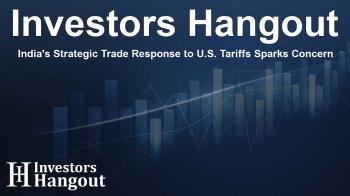India's Strategic Trade Response to U.S. Tariffs Sparks Concern

India's Reaction to U.S. Tariffs
India has announced its intention to retaliate against the United States following the imposition of a significant 25% import duty on foreign-made automobiles and auto components. This decision, communicated to the World Trade Organization (WTO), marks a critical shift in trade relations between the two nations.
Impact of U.S. Tariffs
The Indian government believes that the new duties could adversely affect about $2.89 billion in Indian exports. In light of this, New Delhi has outlined plans to impose countermeasures, targeting a revenue equivalent to the projected $725 million that the U.S. is set to collect from these tariffs.
Statements from Indian Trade Officials
Piyush Goyal, the trade minister of India, has emphasized the necessity of mutual benefit in free trade agreements, stating that negotiations should proceed on reasonable terms rather than under external pressures. His remarks underline India's stance in the ongoing discussions with the U.S.
Negotiation Stance
Despite the latest tariff battles, India remains committed to finding a balanced resolution. The government is keen to ensure that trade agreements benefit both parties equally, which has been a longstanding point of negotiation.
Timing of Retaliatory Measures
The timing of India’s planned retaliatory tariffs coincides with critical negotiations aimed at concluding a bilateral trade agreement. Both nations are racing to achieve a deal before a self-imposed deadline, putting additional urgency into these discussions.
Potential Threats from the U.S.
There are growing concerns regarding further escalations, as President Trump has hinted at imposing a sweeping 26% tariff on all Indian imports should negotiations fail. This looming threat adds pressure on India to respond strategically while safeguarding its trade interests.
India’s Sectoral Resistance
While there may be some openness on India's part to lower certain tariffs, the country has firmly resisted U.S. demands to liberalize its agricultural and dairy sectors. This longstanding point of contention has been a significant hurdle in the negotiations, and India's position remains unchanged despite external pressures.
Endgame and Future Prospects
As both India and the United States navigate this tumultuous trade landscape, the outcomes of their negotiations will likely have lasting implications for future relations. Observers are keen to see how both parties will manage these challenges moving forward and whether they can achieve a resolution that is acceptable to both sides.
Frequently Asked Questions
What triggered India’s retaliatory tariffs against the U.S.?
The tariffs were triggered by the U.S. imposing a 25% import duty on foreign-made automobiles and components, which India estimates will affect $2.89 billion of its exports.
How much does India plan to target in duties?
India is planning countermeasures that would aim for around $725 million in duties, which corresponds to the projected revenue from U.S. tariffs.
What does Piyush Goyal say about free trade agreements?
India’s trade minister has stated that free trade agreements should be based on win-win scenarios, emphasizing they need to be equitable for both nations.
Is India open to lowering tariffs in any sectors?
India has indicated a willingness to negotiate lower tariffs in some areas, yet remains resistant to U.S. demands in agriculture and dairy sectors.
What is the current state of U.S.-India trade relations?
The relations are tense due to recent tariff actions, but both countries are in negotiations aiming for a bilateral agreement amidst these challenges.
About The Author
Contact Riley Hayes privately here. Or send an email with ATTN: Riley Hayes as the subject to contact@investorshangout.com.
About Investors Hangout
Investors Hangout is a leading online stock forum for financial discussion and learning, offering a wide range of free tools and resources. It draws in traders of all levels, who exchange market knowledge, investigate trading tactics, and keep an eye on industry developments in real time. Featuring financial articles, stock message boards, quotes, charts, company profiles, and live news updates. Through cooperative learning and a wealth of informational resources, it helps users from novices creating their first portfolios to experts honing their techniques. Join Investors Hangout today: https://investorshangout.com/
The content of this article is based on factual, publicly available information and does not represent legal, financial, or investment advice. Investors Hangout does not offer financial advice, and the author is not a licensed financial advisor. Consult a qualified advisor before making any financial or investment decisions based on this article. This article should not be considered advice to purchase, sell, or hold any securities or other investments. If any of the material provided here is inaccurate, please contact us for corrections.

